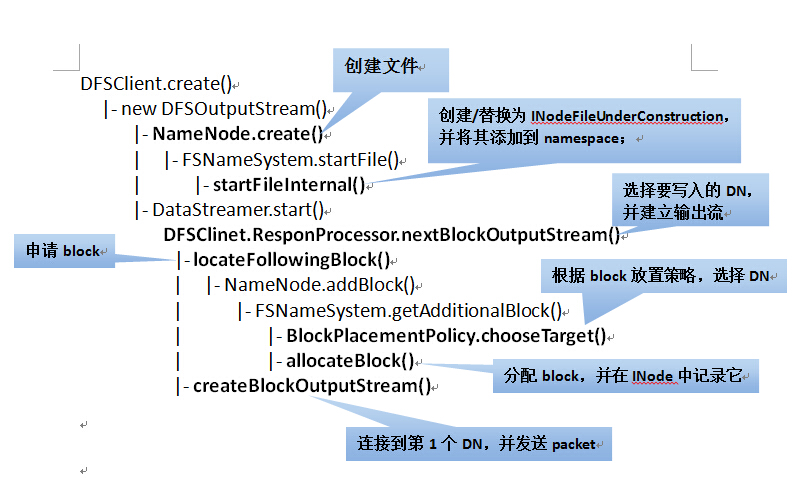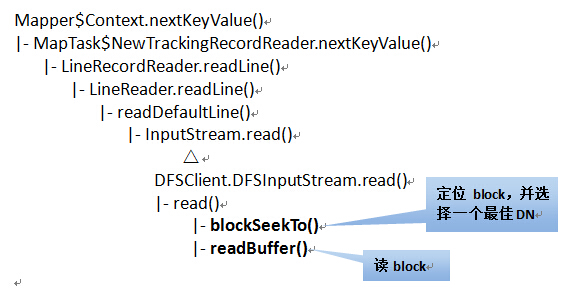最近工作需要,看了HDFS读写数据块这部分。不过可能跟网上大部分帖子不一样,本文主要写了${dfs.data.dir}的选择策略,也就是block在DataNode上的放置策略。我主要是从我们工作需要的角度来读这部分代码的。
1 hdfs-site.xml
2 <property>
3 <name>dfs.data.dir</name>
4 <value>/mnt/datadir1/data,/mnt/datadir2/data,/mnt/datadir3/data</value>
5 </property>
所谓${dfs.data.dir}的选择策略,就是当DataNode配置有多个${dfs.data.dir}目录时(如上面的配置),该选择哪个目录来存放block。一般多个硬盘分别挂载到不同的${dfs.data.dir}下,所以存储block是要决定block该放到哪个磁盘上。
创建文件总共有两步:
1、在写block之前,需要与NameNode通信来生成文件(INodeFile、INodeFileUnderConstruction)。首先在DFSClient端的create()方法中发起写请求,然后通过RPC由NameNode最终调用FSNameSystem的startFileInternal()方法来创建文件。

1 private void startFileInternal(String src, 2 PermissionStatus permissions, 3 String holder, 4 String clientMachine, 5 boolean overwrite, 6 boolean append, 7 boolean createParent, 8 short replication, 9 long blockSize 10 ) throws IOException { 11 if (NameNode.stateChangeLog.isDebugEnabled()) { 12 NameNode.stateChangeLog.debug("DIR* startFile: src=" + src 13 + ", holder=" + holder 14 + ", clientMachine=" + clientMachine 15 + ", createParent=" + createParent 16 + ", replication=" + replication 17 + ", overwrite=" + overwrite 18 + ", append=" + append); 19 } 20 21 FSPermissionChecker pc = getPermissionChecker(); 22 synchronized (this) { 23 if (isInSafeMode()) 24 throw new SafeModeException("Cannot create " + src, safeMode); 25 if (!DFSUtil.isValidName(src)) { 26 throw new IOException("Invalid name: " + src); 27 } 28 29 // Verify that the destination does not exist as a directory already. 30 boolean pathExists = dir.exists(src); 31 if (pathExists && dir.isDir(src)) { 32 throw new IOException("Cannot create "+ src + "; already exists as a directory"); 33 } 34 35 if (isPermissionEnabled) { 36 if (append || (overwrite && pathExists)) { 37 checkPathAccess(pc, src, FsAction.WRITE); 38 } else { 39 checkAncestorAccess(pc, src, FsAction.WRITE); 40 } 41 } 42 43 if (!createParent) { 44 verifyParentDir(src); 45 } 46 47 try { 48 INode myFile = dir.getFileINode(src); //根据路径寻找该文件 49 recoverLeaseInternal(myFile, src, holder, clientMachine, false); 50 51 try { 52 verifyReplication(src, replication, clientMachine); 53 } catch (IOException e) { 54 throw new IOException("failed to create " + e.getMessage()); 55 } 56 if (append) {//若是追加操作 57 if (myFile == null) { 58 throw new FileNotFoundException("failed to append to non-existent " 59 + src + " on client " + clientMachine); 60 } else if (myFile.isDirectory()) { 61 throw new IOException("failed to append to directory " + src 62 + " on client " + clientMachine); 63 } 64 } else if (!dir.isValidToCreate(src)) { 65 if (overwrite) {//允许覆盖原来的文件 66 delete(src, true); 67 } else { 68 throw new IOException("failed to create file " + src 69 + " on client " + clientMachine 70 + " either because the filename is invalid or the file exists"); 71 } 72 } 73 74 DatanodeDescriptor clientNode = host2DataNodeMap 75 .getDatanodeByHost(clientMachine); 76 77 if (append) { 78 // 79 // Replace current node with a INodeUnderConstruction. 80 // Recreate in-memory lease record. 81 // 82 INodeFile node = (INodeFile) myFile; 83 INodeFileUnderConstruction cons = new INodeFileUnderConstruction( 84 node.getLocalNameBytes(), node.getReplication(), 85 node.getModificationTime(), node.getPreferredBlockSize(), 86 node.getBlocks(), node.getPermissionStatus(), holder, 87 clientMachine, clientNode); 88 dir.replaceNode(src, node, cons); 89 leaseManager.addLease(cons.clientName, src); 90 91 } else { 92 // Now we can add the name to the filesystem. This file has no 93 // blocks associated with it. 94 // 95 checkFsObjectLimit(); 96 97 // increment global generation stamp 98 long genstamp = nextGenerationStamp(); 99 INodeFileUnderConstruction newNode = dir.addFile(src, permissions, 100 replication, blockSize, holder, clientMachine, clientNode, 101 genstamp); 102 if (newNode == null) { 103 throw new IOException("DIR* startFile: Unable to add to namespace"); 104 } 105 leaseManager.addLease(newNode.clientName, src); 106 if (NameNode.stateChangeLog.isDebugEnabled()) { 107 NameNode.stateChangeLog.debug("DIR* startFile: " 108 +"add "+src+" to namespace for "+holder); 109 } 110 } 111 } catch (IOException ie) { 112 NameNode.stateChangeLog.warn("DIR* startFile: " 113 +ie.getMessage()); 114 throw ie; 115 } 116 } 117 }
该方法的主要内容如下:
1)首先做一些检查(安全模式、权限、该路径是否已经以文件夹形式存在等)
2)若不是追加操作:
生成generation stamp(针对每个文件生成一个);并构造INodeFileUnderConstruction对象(preferredBlockSize);将这个文件添加到filesystem;添加租约(即有时间限制的写锁);
若是追加操作:
将src下的INodeFile替换成INodeFileUnderConstruction;添加租约;
2、在NameNode端生成文件之后,client向NameNode申请block,并将其写入到DataNode。在上面的工作完成后,就启动DataStreamer线程来向DataNode中写入block。整个流程如下:
1)一些前期检查
2)向NameNode申请block(与NameNode有一次通信)
a. 根据副本放置策略,选择N个DataNode作为block的放置位置;
b. 随机生成一个不重复的blockID;
c. 把该block添加到对应的文件;
3)将目标DN组织成pipeline,并向第一个DN发送Packet
选择其中几个比较重要的方法分析下:

1 /** 2 * The client would like to obtain an additional block for the indicated 3 * filename (which is being written-to). Return an array that consists 4 * of the block, plus a set of machines. The first on this list should 5 * be where the client writes data. Subsequent items in the list must 6 * be provided in the connection to the first datanode. 7 * 8 * Make sure the previous blocks have been reported by datanodes and 9 * are replicated. Will return an empty 2-elt array if we want the 10 * client to "try again later". 11 */ 12 //向NameNode申请block 13 public LocatedBlock getAdditionalBlock(String src, 14 String clientName, 15 HashMap<Node, Node> excludedNodes 16 ) throws IOException { 17 long fileLength, blockSize; 18 int replication; 19 DatanodeDescriptor clientNode = null; 20 Block newBlock = null; 21 22 NameNode.stateChangeLog.debug("BLOCK* getAdditionalBlock: " 23 +src+" for "+clientName); 24 25 synchronized (this) { 26 if (isInSafeMode()) {//check safemode first for failing-fast 27 throw new SafeModeException("Cannot add block to " + src, safeMode); 28 } 29 // have we exceeded the configured limit of fs objects. 30 checkFsObjectLimit(); 31 32 INodeFileUnderConstruction pendingFile = checkLease(src, clientName); 33 34 // 35 // If we fail this, bad things happen! 36 // 37 if (!checkFileProgress(pendingFile, false)) { 38 throw new NotReplicatedYetException("Not replicated yet:" + src); 39 } 40 fileLength = pendingFile.computeContentSummary().getLength(); 41 blockSize = pendingFile.getPreferredBlockSize(); 42 clientNode = pendingFile.getClientNode(); 43 replication = (int)pendingFile.getReplication(); 44 } 45 46 // choose targets for the new block to be allocated. 47 //选择副本存放的位置 48 DatanodeDescriptor targets[] = replicator.chooseTarget(src, 49 replication, 50 clientNode, 51 excludedNodes, 52 blockSize); 53 if (targets.length < this.minReplication) { 54 throw new IOException("File " + src + " could only be replicated to " + 55 targets.length + " nodes, instead of " + 56 minReplication); 57 } 58 59 // Allocate a new block and record it in the INode. 60 synchronized (this) { 61 if (isInSafeMode()) { //make sure it is not in safemode again. 62 throw new SafeModeException("Cannot add block to " + src, safeMode); 63 } 64 INode[] pathINodes = dir.getExistingPathINodes(src); 65 int inodesLen = pathINodes.length; 66 checkLease(src, clientName, pathINodes[inodesLen-1]); 67 INodeFileUnderConstruction pendingFile = (INodeFileUnderConstruction) 68 pathINodes[inodesLen - 1]; 69 70 if (!checkFileProgress(pendingFile, false)) { 71 throw new NotReplicatedYetException("Not replicated yet:" + src); 72 } 73 74 // allocate new block record block locations in INode. 75 //分配block,并随机生成一个不重复的blockID,然后在INode中记录该block 76 newBlock = allocateBlock(src, pathINodes); 77 pendingFile.setTargets(targets); 78 79 for (DatanodeDescriptor dn : targets) { 80 dn.incBlocksScheduled(); 81 } 82 dir.persistBlocks(src, pendingFile); 83 } 84 if (persistBlocks) { 85 getEditLog().logSync(); 86 } 87 88 // Create next block 89 LocatedBlock b = new LocatedBlock(newBlock, targets, fileLength); 90 if (isAccessTokenEnabled) { 91 b.setBlockToken(accessTokenHandler.generateToken(b.getBlock(), 92 EnumSet.of(BlockTokenSecretManager.AccessMode.WRITE))); 93 } 94 return b; 95 }
上面的方法还涉及到了块的选择策略,这个留在下一篇再说。下面这个图来总结下上面方法的调用层次:

最后重点说一下block在DataNode上的存储策略。其调度层次如下:

首先说一下其中涉及到的数据结构:
1 class FSVolume { //卷信息,代表${dfs.data.dir}
2 private File currentDir; //存放block,即${dfs.data.dir}/current
3 private FSDir dataDir; //表示currentDir有哪些块文件
4 private File tmpDir; //存放一些临时文件,即${dfs.data.dir}/tmp
5 private File blocksBeingWritten; //放置正在写的block,即${dfs.data.dir}/ blocksBeingWritten
6 private File detachDir; //是否写分离,即${dfs.data.dir}/detach
7 private DF usage;
8 private DU dfsUsage;
9 private long reserved;
1 static class FSVolumeSet { //卷信息集合,代表多个${dfs.data.dir}
2 FSVolume[] volumes = null; //代表多个FSVolume,并将其组织成一个数组
3 int curVolume = 0; //指示当前正在使用哪一个FSVolume
FSVolumeSet 代表多个${dfs.data.dir}目录的集合,它将这些目录组织成一个数组volumes,然后用curVolume来指示当前正在使用的是哪个${dfs.data.dir}目录。${dfs.data.dir}的选择策略如下:
当有多个${dfs.data.dir}时,DataNode顺序地从volumes选择一个FSVolume用来存放block(先放在blocksBeingWritten目录下,写完后再转移到current目录下);
每次写完一个block, curVolume增1。以此实现多个${dfs.data.dir}目录的轮流写。该策略在FSDataSet.FSVolumeSet的getNextVolume()方法中实现。
1 synchronized FSVolume getNextVolume(long blockSize) throws IOException {
2
3 if(volumes.length < 1) {
4 throw new DiskOutOfSpaceException("No more available volumes");
5 }
6
7 // since volumes could've been removed because of the failure
8 // make sure we are not out of bounds
9 if(curVolume >= volumes.length) {
10 curVolume = 0;
11 }
12
13 int startVolume = curVolume;
14
15 while (true) {
16 FSVolume volume = volumes[curVolume];
17 curVolume = (curVolume + 1) % volumes.length; //增1
18 if (volume.getAvailable() > blockSize) { return volume; }
19 if (curVolume == startVolume) {
20 throw new DiskOutOfSpaceException("Insufficient space for an additional block");
21 }
22 }
23 }
接着来说一下读block的过程。在Map Task执行时,nextKeyValue()方法来从block中读取数据,主要步骤如下:
1、根据创建Map Task时指定的文件偏移量和长度,来确定应该读取哪个block,并获取这个block的详细信息。(与NameNode有一次通信)。
2、根据block所在的DataNode,选择一个最好的DN,并建立与该DN的socket连接(默认不启用本地读)。
其方法的调用层次如下:

Map Task读取数据是由RecordReader类来完成的。它是个接口,有两个子类:
BlockReaderLocal:读取本地block(不通过DataNode)
RemoteBlockReader:读取远程block(通过DataNode)
Map Task在读取数据时,即使是本地数据也是使用RemoteBlockReader来读的,也就是通过socket,默认不开启本地读。通过这个链接的方法可以开启本地读(http://hadoop.apache.org/docs/current/hadoop-project-dist/hadoop-hdfs/ShortCircuitLocalReads.html),也就是使用BlockReaderLocal直接来从本地读block,而不通过DataNode。以下的分析都是基于BlockReaderLocal来完成的。
先说一下涉及到的数据结构:
1 public class BlockLocalPathInfo implements Writable { //用来描述block的位置信息
2
3 private Block block; //特定的块文件
4 private String localBlockPath = ""; //块文件的本地存储路径
5 private String localMetaPath = ""; //块校验文件的本地存储路径
1 //Stores the cache and proxy for a local datanode.
2 private static class LocalDatanodeInfo { //代表本机上的某个DataNode(一个机器上可能运行多个DataNode)
3 private final Map<Block, BlockLocalPathInfo> cache; //其中维护的表(block-->block位置信息)
1 // Multiple datanodes could be running on the local machine. Store proxies in
2 // a map keyed by the ipc port of the datanode.
3 //BlockReaderLocal中维护的表:
4 private static Map<Integer, LocalDatanodeInfo> localDatanodeInfoMap = new HashMap<Integer, LocalDatanodeInfo>();
5 // Integer:表示端口号
6 // LocalDatanodeInfo:表示某个DataNode
1 /**
2 * This class is used by the datanode to maintain the map from a block
3 * to its metadata.
4 */
5 class DatanodeBlockInfo { //表示该DN上的所有block信息(block-->block元信息)
6
7 private FSVolume volume; //block所在的FSVolume
8 private File file; // block file
9 private boolean detached; // block的写复制是否完成
1 //block与block元信息映射表
2 HashMap<Block,DatanodeBlockInfo> volumeMap = new HashMap<Block, DatanodeBlockInfo>();;
在读block时,首先根据localDatanodeInfoMap确定要访问的DataNode;然后从volumeMap中找到block对应的DatanodeBlockInfo信息(这其中就包括block对应的FSVolume,这是在存储block时确定的。本文前边有写);然后根据DatanodeBlockInfo来构造BlockLocalPathInfo对象,将block的相关信息存放到BlockLocalPathInfo对象中。最后BlockReaderLocal根据BlockLocalPathInfo对象来读取相应的block。 具体在BlockReaderLocal.newBlockReader()方法中。
本文基于hadoop1.2.1
如有错误,还请指正
